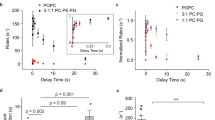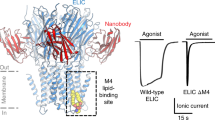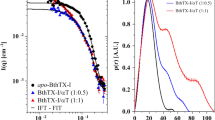Abstract
OPIATE receptors in animal and human brain have been shown to be tightly associated with cell membranes1–3. Our laboratory has reported the solubilisation of an etorphine–receptor complex4, but to date it has not been possible to obtain an active receptor in soluble form. Nevertheless, it has been possible to study many biochemical characteristics of the membrane-bound receptor. Its sensitivity to sulphhydryl reagents and a number of other protein reagents5,6 as well as to proteolytic enzymes1,7 suggests the participation of protein(s) in opiate binding. The evidence is less clear with respect to a function for phospholipids. Opiate binding activity of cell membrane preparations from rat brain has been shown to be exquisitely sensitive to phospholipase A of Vipera russelli venom (in the ng ml−1 range)8, but very insensitive to phospholipase A present in the venom of Crotalus adamenteus1 or that derived from pig pancreas (Lin & Simon, unpublished). Phospholipase C is inhibitory only in very high concentrations1,8. The great sensitivity of opiate receptors to the Russell's viper enzyme and to ionic and non-ionic detergents4,7 points to a possible role for phospholipids in the binding process. We report here that inhibition of opiate binding by phospholipase A can be reversed almost completely by incubation of the enzyme-treated membranes with bovine serum albumin (BSA).
This is a preview of subscription content, access via your institution
Access options
Subscribe to this journal
Receive 51 print issues and online access
$199.00 per year
only $3.90 per issue
Buy this article
- Purchase on Springer Link
- Instant access to full article PDF
Prices may be subject to local taxes which are calculated during checkout
Similar content being viewed by others
References
Simon, E. J., Hiller, J. M. & Edelman, I. Proc. natn. Acad. Sci. U.S.A. 70, 1947–1949 (1973).
Pert, C. B. & Snyder, S. H. Science 179, 1011–1014 (1973).
Terenius, L. Acta pharmac. toxicol. 32, 317–320 (1973).
Simon, E. J., Hiller, J. M. & Edelman, I. Science 190, 389–390 (1975).
Simon, E. J. & Groth, J. Proc. natn. Acad. Sci. U.S.A. 72, 2404–2407 (1975).
Pasternak, G. W., Wilson, H. A. & Snyder, S. H. Molec. Pharmac. 11, 340–351 (1975).
Pasternak, G. W. & Snyder, S. H. Molec. Pharmac. 10, 183–193 (1974).
Pasternak, G. W. & Snyder, S. H. Molec. Pharmac. 11, 478–484 (1975).
Simon, E. J., Hiller, J. M., Groth, J. & Edelman, I. J. Pharmac. exp. Ther. 192, 531–537 (1975).
Azhar, S., Hajra, A. K. & Menon, K. M. J. J. biol. Chem. 251, 7405–7412 (1976).
Author information
Authors and Affiliations
Rights and permissions
About this article
Cite this article
LIN, HK., SIMON, E. Phospholipase A inhibition of opiate receptor binding can be reversed by albumin. Nature 271, 383–384 (1978). https://doi.org/10.1038/271383a0
Received:
Accepted:
Published:
Issue Date:
DOI: https://doi.org/10.1038/271383a0
This article is cited by
-
Influence of plasma proteins on activity of proinflammatory enzyme phospholipase A2
Inflammation (1986)
-
In vitro modulation of stimulus-induced cyclic AMP formation by a synthetic antioxidant
Bulletin of Experimental Biology and Medicine (1986)
-
Activation of fluoride-stimulated adenylate cyclase by phospholipase A2 in the caudate nucleus of the rat brain
Neurochemical Research (1983)
Comments
By submitting a comment you agree to abide by our Terms and Community Guidelines. If you find something abusive or that does not comply with our terms or guidelines please flag it as inappropriate.



